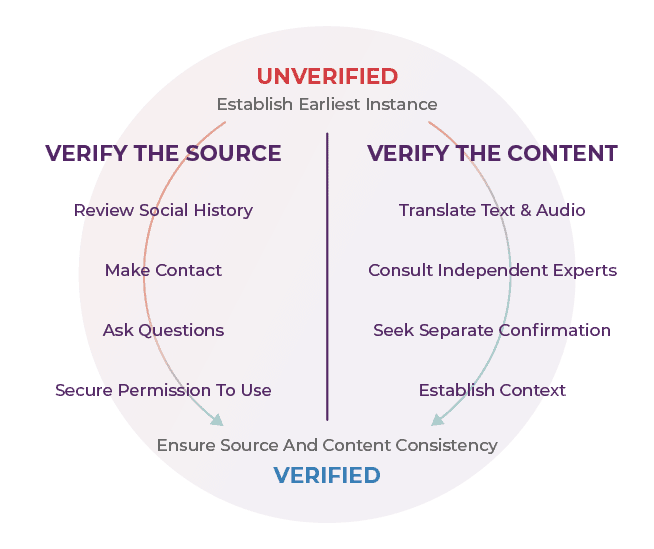Verification
What is verification?
Verification is the process of making sure your content is accurate. It is easy to get caught up in the moment during a breaking news event. Crises can make it challenging for journalists to keep their cool. You stumble across some great content and you think you might be first because nobody else has run it yet. But in the haste, you forget some of the golden rules. This can lead to making mistakes and, once that happens, a potentially great piece loses all credibility.

The five pillars of verification
- Origin: Where did the article or piece of content originate from? Is this the original?
- Source: Who wrote or created the original content?
- Date: When was it written or created?
- Location: What website or account was the content published on originally?
- Motivation: Why did the website or account choose to publish the content?
Origin
If you are trying to find the first version of a meme or suspicious claim, before it made it into the mainstream, it is sometimes worth searching in these spaces:
- Check Reddit: You can use the native search bar, or Reddit monitoring tool like TrackReddit.com.
- 4chansearch.com allows you to search 4chan and 4chan archive sites.
- Gab.ai is an alt-Twitter platform where many users who have been suspended have migrated.
- Discord channels, Facebook groups and WhatsApp groups are more difficult to find and search but may be worth the effort for deeper dives.
Source
- Contact: contact the person, either by calling or private messaging them.
- Question: ask the person questions, if they are not genuine, they may be vague about the facts.
- Permission: if the person does not have the right to let you use the content you are enquiring about; they will not be keen to undergo formal permissions.
Date
Finding the correct date for when the content was written or created can help in identifying the reliability, truthfulness and correctness of the content.
Motivation
You can also ask yourself why the information was shared:
- Is it clear that the authors wanted to sell the audience something?
- Inform them?
- Entertain them?
- Persuade them of a point of view?
- Teach them?
- Is the information presented impartially and objectively?
- Are there obvious biases: political, religious, institutional?
All of these questions should help you judge how to deal with the information.
Verifying content: verifying images
Ten tips to ask yourself when fact-checking photos:
- Can you find when the picture was first used?
- What is the context the picture was used in?
- Who is in the picture? Do they fit in? What clothes are they wearing? Is it the right style for the country the picture was allegedly taken in?
- What is the weather like in the photo? If the photo is recent, is it the right season for that country?
- Look at any writing in the photo, like road signs and shopfronts. Is it in the correct language?
- Check for inconsistent lighting or slight variations in light or colour in the photo. If some objects seem brighter or duller than others, there is a chance they could have been added or digitally manipulated.
- If there are distortions along the edges of people or objects, the picture has probably been poorly manipulated.
- Check, check and check again, before you tweet or post.
- If someone posts something that is old or “fake”, politely let them know.
- Be part of the solution! Follow these tips so you do not contribute to “fake” news.
Geolocation for images and videos: a 7-step process
- Find the original: For the best, and most credible, verification you want the oldest or original posting. Try and use reverse image searching or text searching on Google, Facebook, YouTube, Twitter, and other open sources to find the original.
- Source Analysis: Evaluate the original poster’s credibility. Ask yourself: Where are they posting from? When are they posting? Who is following them? Who are they engaging with online?
- Gather Leads: Find any information in the caption or reposts of the media mentioning the location where the video was recorded or what it is showing.
- Identify landmarks: Look for buildings, fields, trees, roads, or anything else you could potentially see from satellite imagery.
- Visual comparison and Analysis: Compare your identified landmarks with what is shown on satellite imagery. If stuck do more discovery
- If you can’t locate the video, try searching for more images or videos that show that location or the surrounding areas.
- Visualize & document your findings: Use tools such as Keynote, Google Draw, and ones provided by Knightlab to present your findings.
Verification tools
Tools for Verifying Images
- Google reverse image search
- FotoForensics
- Exifdata
- Exiftool
- MetaData2Go
- Forensically
- Tin Eye Image Verification
Tools for Verifying sources
Tools for Verifying Video
Tools for Verifying Content/News

